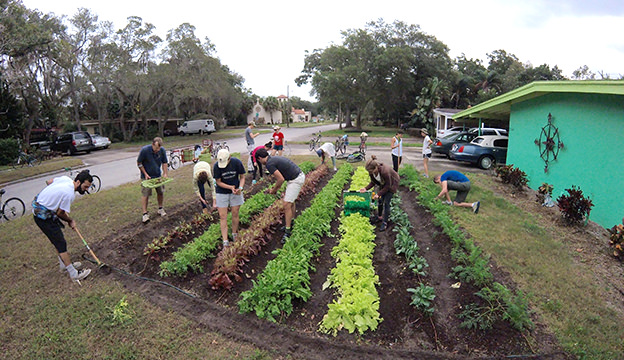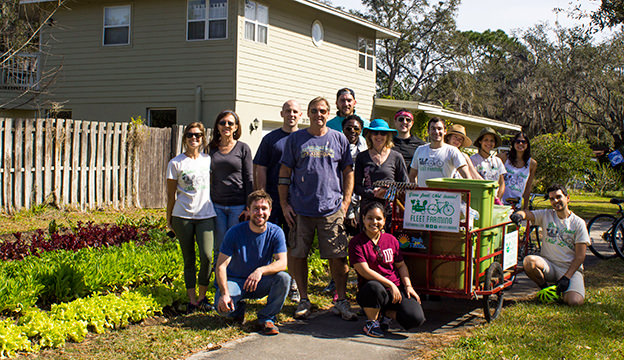Wearing a T-shirt that says “Grow Food, Not Lawns,” a Fleet Farming volunteer pedals alongside fellow cyclists through an Orlando, Fla., neighborhoods. The bicycle posse—dubbed The Swarm—has one mission: to empower people to grow their own healthy, organic food. Heather Grove, an advisor for the Orlando-based, urban-farming initiative talks about the innovative bike-powered crew’s efforts to shorten food miles by planting and supporting lawn farms across their city.
From seed to cycle, how does Fleet Farming work?
Most of the people who donate their lawns for our Fleet Farming project are novice gardeners who want to learn how to grow their own food. They offer a small piece of their land for a farmlette, and we do everything: prepping the soil, weeding, harvesting and even installing an irrigation system. Our bike-powered urban farming fleet rides to the farmlettes. Cycling is a good way to reduce our carbon footprint, stay fit and build camaraderie. It’s a really great group of people!
The homeowners are not required to grow anything, but we want them to eventually adapt and grow their own food. They are allowed to harvest anything they want to from the plot, and the rest of the harvest is sold at market to support the program.
What was the inspiration for Fleet Farming?

We were inspired by a number of successful urban farmers, like Curtis Stone and Jean-Martin Fortier, but the idea of a pedal-powered urban-farming program was proposed at a monthly think-and-do tank called The Hive in December 2013. The attendees were tasked with creating a carbon-neutral model of agriculture, hence the hyper-local distributed agriculture program.
By turning grass into gardens and utilizing bikes for transportation, a group of volunteers with IDEAS For Us, Inc. created this profitable, scalable and successful model.
Tell me about the farmlettes The Swarm visits.
We have 11 farmlettes. One is at East End Market, a local food hub, and is 800 square feet. Our largest 1,500- square-foot farmlette is at a local church. The other nine farmlettes are at private residences. Each one is different. One is curved around a driveway while others are basic rectangles.
We mostly grow lettuce and microgreens, but we are starting to grow more edible flowers, as well. Our growing season is from October to May, and we use cover crops in the summer. All of our farmlettes are within a 5-mile radius, but we hope to have more branches around Orlando soon.
Are there other Fleet Farming programs elsewhere?

To my knowledge, I don’t know of any non-profit programs like Fleet. Because our model has been so successful, we’ve branched out into more Fleet Farming operations in Orlando, Oakland, Calif., and even internationally in Uganda.
If people are interested in starting their own Fleet program, we have a comprehensive tool kit that we sell for $75. The kit provides all the information—from Excel spreadsheets to info on how to coordinate volunteers—that one needs to create their own Fleet Farming program in their community.
What have you accomplished with Fleet Farming?
We were profitable in our first year. We sell out at the market every time. Besides financial benefits, Fleet has provided organic food to the community and local restaurants. Our volunteers learn how to garden and stay active on bikes.
Fleet Farming Facts By The Numbers
- Two paid staff run the program.
- 2,000-plus pounds of salad sold.
- 250-plus residents want to have farmlettes on their property in the Orlanda area.
- 40 Swarm volunteer riders participate each month
- 300 volunteers have been engaged since the first Swarm Ride.
- 11 farmlettes currently exist. (The goal is 20 farmlettes by the end of 2016.)
- 2-by-20 feet is the size of the rows in Fleet’s SPIN model of gardening.
- $300 is the cost for a farmlette participant or three years
Check out the Fleet Farming website for more info on starting your own Fleet Farming program.




